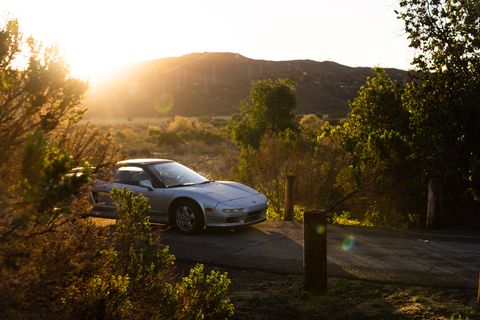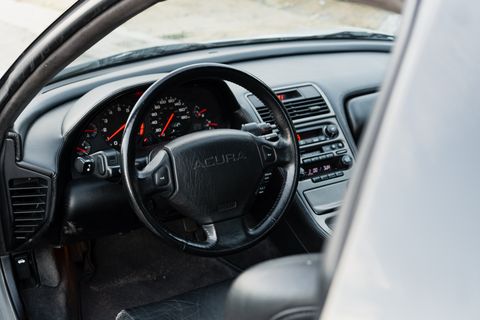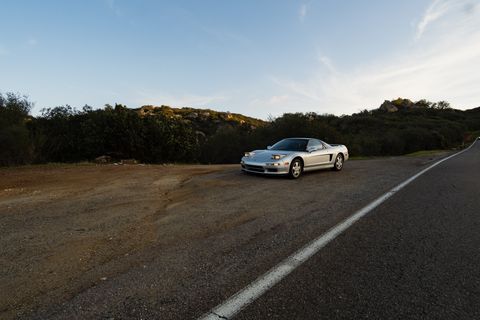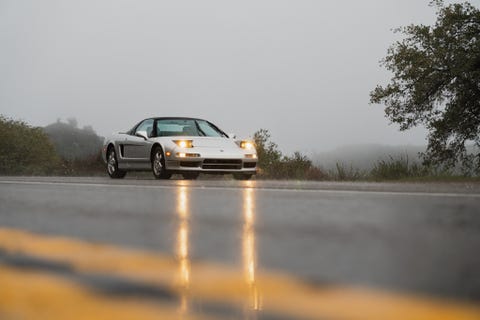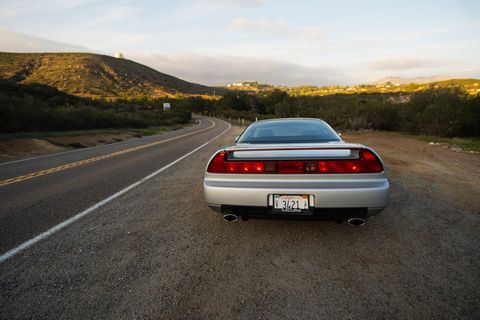[ad_1]
It’s nothing but two shifts. A three-two downshift and a two-three up. In between, I move to the left lane of the I-5 as we blast toward downtown San Diego, a silver Camry slips behind in the peripherals. A lifetime friend, brother even, headbangs in the right seat to the beat of the Paramore song blasting from the speakers. Windows down, 68 and sunny, we’re living the California dream. A second after the upshift I spot a cop, too far ahead to have seen anything. I lift.
The memory sets. Five years into life in this business, I’ve learned it’s only about those moments. The two- to ten-second bursts where everything, everything, is right. Every argument about the greats, every Performance Car of the Year discussion, every bit of everything you know about sports cars comes down to them. Nothing matters but the moments of perfect harmony with the machine and environment. And the NSX pulls them out of thin air, even on busy interstates.
The reason why is obvious. The NSX is supercar simplicity incarnate. It has lost what it never truly had—any ability to wow anyone with numbers. Instead it delivers a direct mechanical connection. So that V-6 makes “only” 270 hp, but it does that with an intoxicating rush of VTEC and a muscling bellow that doesn’t stop until the 8000 rpm redline (cutoff isn’t until 8300 rpm). At that point, I grab the next gear with a perfect Honda shifter and a light, easy clutch, feel the engine jump back into a rhythm, and rocket off again.
The lack of power steering, annoying around town, proves worth it once a corner arrives. The NSX is instantaneous with its feedback and immediate in its execution of commands. The total lack of intermediary between your movements and the wheels’ provides clarity and confidence. That can’t be found in a more modern car. And that, in turn, helps make the best use of the NSX’s always poised chassis.
This car once set the benchmark for suspension tuning. By that I don’t mean the subjective benchmark or the enthusiast benchmark, but the actual benchmark pegged by Gordon Murray when he designed the McLaren F1. Many cars can claim inspiration from the F1—oft considered the greatest car of all time—but few others can claim to have inspired it.
Murray, whose current flagship project is a 2174-lb naturally aspirated V12 hypercar without power steering, knows the value of lightweight construction and high-quality parts. It’s no wonder he fell for the NSX, with its non-adjustable double-wishbone front and rear suspension and groundbreaking aluminum construction. It weighs just 3010 lbs, but still has air conditioning and a Bose stereo. This is a car that’s meant to be driven.
So I keep driving. Down the mountain roads then up them again, over to a campsite, up the coast, across town for groceries, it doesn’t matter. The NSX, superb as it is as a weekend toy, also functions as a car. It’s no wonder that people have put two-, three-, and four-hundred thousand miles on some of them. The only thing to hold you back is the tight trunk and low nose. Everything else is effortless.
And a second later, I can access the thrill.
The beauty of a supercar that isn’t modern-supercar quick is that I can boot it on an onramp without putting my license on the line, or stretch the limits of grip without being forced to think about the crash structure of a car from 30 years ago. With 205s in the front and 225s out back, the NSX has enough grip, but not so much that you don’t have to work for your speed. It ain’t gonna hand it out.
This is the enduring success of the NSX. It’s the reason I get misty-eyed thinking about it, the Miata, the 289 Cobra, and the Lotus Evora. Everything today hands you speed on a platter. Tires get bigger, computers get smarter, and power figures get commas in them. All of this tries to wow you with nerve-frying acceleration and everywhere, anytime grip. But that’s not what we’re here for.
The love of driving is about pushing the boundary, dancing in unmarked territory on the map. We find speed with which we’re comfortable, and then we see what lies beyond. When we run into a problem, we fix it ourselves.
But we’re human. Without hundreds of laps of practice, most of us can’t react quickly enough to cope with 700 hp on our own. Even if we could, weights have ballooned so much that it’s hard to make a chassis that reacts intuitively and quickly enough for you to save yourself. We lean on computers because they’re the only way we can handle the power we want.
The NSX, though, is a reminder of the other way. Sure, computerized everything is the only way to handle 1000 hp. But what if you only had 270 hp? And what if, despite everything the commercials tell you, it was enough? Then you’d have to accept a car that is neither as impressive nor as instantly mind-boggling as a modern super-sedan. You’d have to give up some of the comforts you’re told you can’t live without. And you’d have to deal with the compromises inherent in a lightweight platform like the NSX or Miata.
But drive a car balanced on the edge of the world, its fate determined by your confidence and competence, and I promise you won’t care. You’ll just want more of those moments.
This content is created and maintained by a third party, and imported onto this page to help users provide their email addresses. You may be able to find more information about this and similar content at piano.io
[ad_2]
Source link

